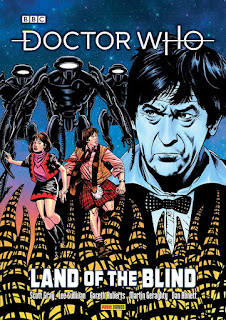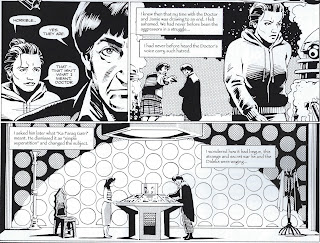And so it begins! As has been the case since 2017, I am voting in the Hugo Awards this year. Most finalists, I read either via the voter's packet or the library, and those I just write up as part of my final ballot posts. But I usually buy all the Best Novel finalists, plus any other finalists of sufficient interest, and those I'll be writing up on Tuesdays over the next few months, starting with...
Strange Adventures
 |
|
Collection published: 2021 Contents published: 2020-21 Acquired: April 2022 Read: May 2022 |
Letterer: Clayton Cowles
Tom King definitely has a "thing." I've previously read his work in The Omega Men (2015-16), The Vision (2016-17), and Mister Miracle (2017-19), and in my review of the last one, I wrote, "This feels to me like it finishes a thematic trilogy.... Like those stories, it's about reconciling superpowered violence with living an everyday life." Well, the stories may be thematically connected, but his work on Strange Adventures shows that he's not done with those ideas yet. Through the story of Adam Strange, he refracts them in a different way, and I would describe what's as stake here as masculinity, violence, and empire—all through the medium of superhero adventure comics, of course.
Adam Strange is the "Man of the Two Worlds," a human from Earth who fights to defend the planet Rann. Strange Adventures follows him in two parallel stories: in the past, he fights alongside his wife Alanna to defend Rann from the deadly Pykkt invasion. In the present, the two now reside on Earth, where Adam has become a hero and celebrity for defeating the Pykkts... but their daughter is dead, and the promise of a Pykkt invasion of Earth looms. We see what Adam and Alanna did in sequences illustrated by Evan "Doc" Shaner in the past while the Stranges defend themselves against accusations of impropriety in the present, especially a Justice League investigation run by Mister Terrific.
 |
| Beware the Pykkts! from Strange Adventures vol. 5 #1 (art by Evan "Doc" Shaner) |
Fundamentally, what King and his collaborators have done here is to take a Space Age gee-whiz comics concept and darken it. In the original series, Adam travels to Rann via zeta beam, fights alien monsters with science knowledge, kisses Alanna, and goes home, ad infinitum. I do feel like I could nitpick how King did this to death if I wanted to. Is this series doing anything that DC's last dark Adam Strange reinvention didn't? Well, actually, yes. Richard Bruning's series was interested in the histories of both Adam and Rann: what would make a person want to abandon his planet like this? why would a technologically advanced alien civilization need a guy from Earth to save them all the time? King doesn't really care about this; Adam's Space Age adventures are mostly there to contrast the horribleness and moral compromise of the Pykkt invasion. Along those lines, then, I actually wanted more deconstruction of the relationship between Adam and Rann: it kind of reads like the kind of thing we might now call a "white savior" narrative, and though there are hints of it, that's not really the story King is telling either, and I guess I can't begrudge him for that.
As you read the book, it becomes clear that the present-day story is Alanna's, not really Adam's. And, after all, the book is Strange Adventures, not Adam Strange: it doesn't specify which Strange in the title. The relationship between Adam and Alanna is the crux of the whole book, and it's fascinating and terrifying. Adam, as the book flags up on occasion, especially through Adam's media appearances on contemporary Earth, is a man. He's the kind of guy who does what needs to be done to save his people, and then romances a woman. This is shown to be Alanna's own doing in many ways: she shaped Adam into being the kind of man she wanted, and through extension, Rann needed. This worked for him for decades!
 |
| She may look nicer... from Strange Adventures vol. 5 #5 (art by Mitch Gerads) |
What Strange Adventures does is take that concept of masculinity and put it through the wringer. What if "what needs to be done" is more complicated than decisively implementing a science idea you've had? As the war against the Pykkts goes on, Adam must do more and more, pushed by Alanna on every step. Soon we see the dark side of that masculinity—and in the book's ultimate revelation, so does Alanna. Adam was pushed into a situation where his masculinity became untenable; in order to save the day in the way he was supposed to yet again, he had to betray the precepts he supposedly stood for. You can see both how Alanna pushed him into it... and how in becoming the person Alanna wanted him to be, he ultimately snapped, revealing the weaknesses at the heart of masculine identity. Alanna, in the end, recognizes this but doesn't let herself see it. In a sense, this story is about revealing that Adam Strange is a villain, but Adam is only a villain to the extent that masculinity has forced him to be one, and Alanna is the embodiment of the enforcement of masculinity. She makes him live up to an ideal that is ultimately impossible to live up to.
 |
| ...but she is the truly dangerous Strange. from Strange Adventures vol. 5 #7 (art by Mitch Gerads) |
My biggest complaint would be the use of grawlixes,
actually. You can show a guy's head explode, and show multiple sex
scenes, but you can't use the work "fuck"? It threw me out of the moment
almost every time.
 |
| Like clearly this panel would be better if it just said "Just fucking try to be a man." from Strange Adventures vol. 5 #10 (art by Mitch Gerads) |
So, yeah, there's a lot going on here, and I really enjoyed reading it. I think it might be my favorite of the Tom King comics I've read, though maybe that would also be The Omega Men. As a writer, King is replete with small touches that make things come alive. There are good jokes, some nice media and political commentary, a neat take on Mister Terrific, good characterization for all the different superhero cameos (Superman, Batman, and even Booster Gold), and interesting epigraphs. The art is perfect. I liked Mitch Gerads on Mister Miracle, but he absolutely kills it on the present-day sequences here, especially anything involving Alanna. Evan "Doc" Shaner has been a favorite of mine since I read his Convergence: Shazam miniseries, and his clear, heroic art is beautiful on its own terms and beautiful as a contrast to the horrific events it depicts. I assume Gerads and Shaner did their own coloring because there's no credited colorist, and the colors are great, too, really adding to the mood and tone and surrealism of the piece as appropriate.
 |
| Arming herself to do battle. from Strange Adventures vol. 5 #10 (art by Mitch Gerads) |
If King stops doing his dark deconstructions of male superheroes here, it will be a worthy conclusion. But if he keeps going, I will be along for the ride. And when will Evan Shaner get something other than Future Quest to really shine on!?
 |
| But I will take whatever Doc Shaner I can get. from Strange Adventures vol. 5 #2 (art by Evan "Doc" Shaner) |
Side note: over the past few years, primarily beginning with 2009's Strange Adventures vol. 3, DC has associated Adam Strange with the title Strange Adventures. It's a natural association if you go by the name, but historically, Adam Strange's adventures mostly appeared in Mystery in Space. It occurred to me near the end of the volume that "Mystery in Space" would actually be a plausible collection for this story, too... and then like a page later, Alanna used it in text!
























